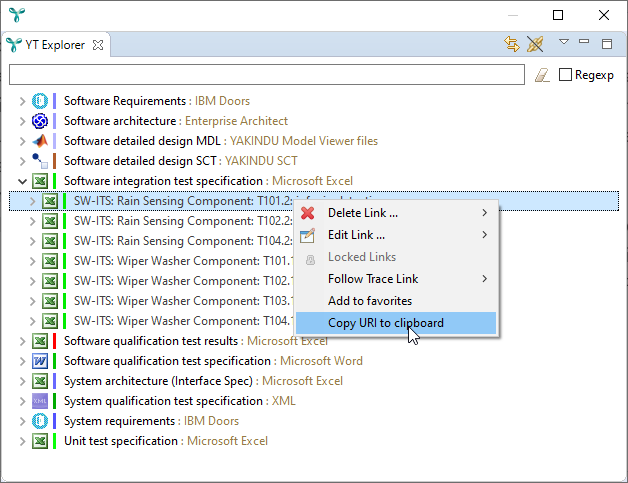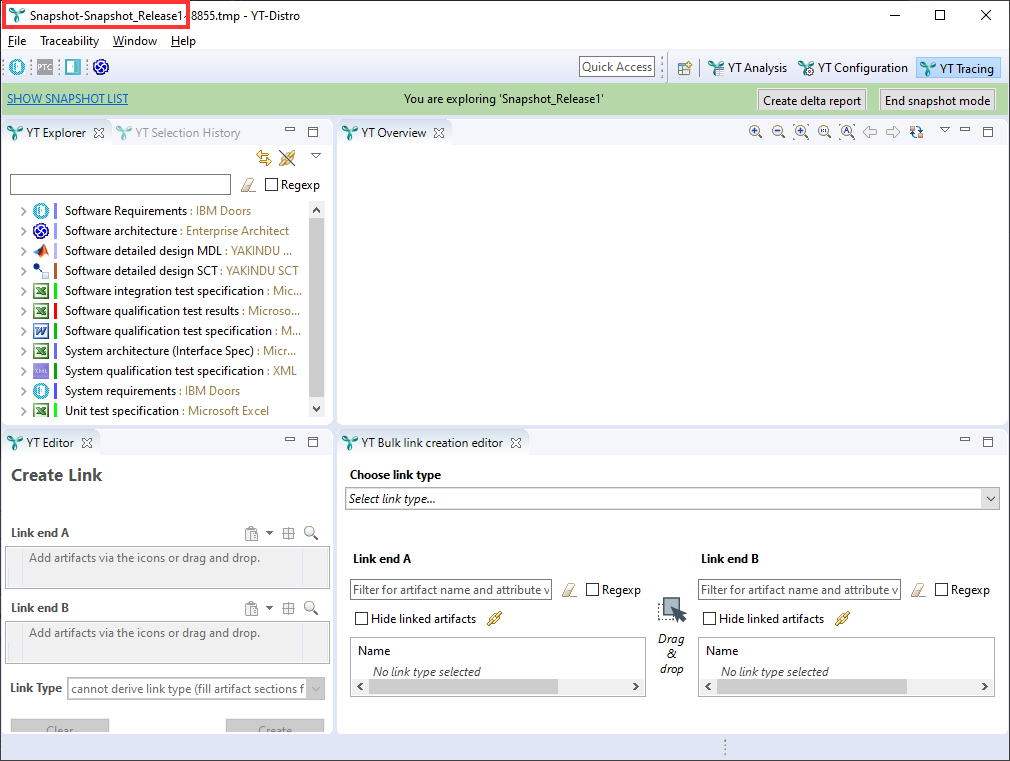Table of contents
R release (RM5 1.1.2116) Copy link to clipboard
User Interface improvements (and more) Copy link to clipboard
YAKINDU Traceability now supports hyperlinking across tools Copy link to clipboard
You know that YT provides cross-tool navigation support. For example, if you double-click an artifact in YT that represents a test case in Excel, YT opens Excel for you and navigates to the sheet/cell that contains the test case. We have added support to trigger this navigation from outside YT – by means of URIs. In YT, you can copy the URI that points to an artifact and use that URI as a hyperlink.

This link opens/selects the artifact in the corresponding engineering tool (e.g. a test case in Excel or a requirement in DOORS). You can use this like a http-hyperlink; you can e.g. save in a document.
The URI has the form
yakindutraceability:/%2Ftest.specification%2FSoftware_integration_test_specification.xlsx?Software%20integration%20test%20specification#Rain%20Sensing%20Component:%20T101.2
Note: To support this navigation, YT will ask you to register a hander for the yakindutraceability protocol. You need a running YT on your system to use the hyperlink.
YT Snapshot Viewer displays the name of the snapshot explicitly Copy link to clipboard
When working with multiple snapshots at the same point in time, it is sometimes hard to distinguish to identify the snapshot that you are looking at. To avoid confusion, the snapshot viewer now uses the title of the snapshot.

YT Search Dialog is automatically closed on reload Copy link to clipboard
If you opened a YT Search Dialog and triggered a reload of traceability data (e.g. by changing the YT configuration or by selecting Reload current configuration in the menu, an open search dialog was empty after the reload. Now, we close any YT Search Dialog on reload.
Improved help section describing YT query language Copy link to clipboard
The help section was lacking descriptions of artifactByIndex and linksFromTo functions. We added them.
Suppression of dialogs in batch mode Copy link to clipboard
Some Eclipse plug-ins which are not under control of YAKINDU Traceability may require user input. This is e.g. true if the subversion plug-in detects a repository with outdated metadata: It asks the user whether he wants to migrate the repository to a newer version. These dialogs may be blockers in batch mode. We implemented a routing which automatically closes all custom dialogs in batch mode.
Adapter improvements Copy link to clipboard
DOORS Next Improvements Copy link to clipboard
- The adapter now supports filtering based on projects, streams, and component/collections specific attributes.
- We support the extraction multi-valued attributes.
- You can now map the artifactURI as a custom attribute in YT.
- It is now possible to map attributes of collections and use them as filter criteria:
include objects if {
collections.valueOf("ForeignID") == "<number>"
}
name valueOf("Type") + " : " + valueOf ("Identifier")
map {
collectionID to collections.valueOf("ForeignID")
} - For custom attributes, the DOORS next adapter retrieved the URI representing the value of an attribute. These URIs are not easily to read. Instead of reading the URIs, YT now retrieves the value which is identified by the URI.
- We can read many artifacts. We go beyond the limit that is set in the DOORS Next configuration (usually DOORS next does not return more than 3000 requirements per query). We use paging to go beyond this limit.
- In addition, we improved the suggestions (proposals) in the configuration editor.
- We made the progress report for downloads more accurate
Note that we also renamed the adapter from „IBM DOORS Next Generation” to „IBM DOORS Next” to reflect IBM’s naming decision.
Find a detailed description of configuration possibilities in our
help .
Improved Excel adapter Copy link to clipboard
It is now possible to create more than one representation of the same real-world artifact (i.e. a specific Excel cell) in YT.
Imagine you have an Excel sheet containing the test case specification the test results in the same table.

If your development standard mandates that a distinction must be made explicitly between test and result, and that two separate traceability artifacts are required for this, this can now be mapped with YT using two artifact types. Of course, YT automatically links the related artifacts.
Bug Fixes Copy link to clipboard
Two bug fixes for DOORS classic: Copy link to clipboard
Fix for „==” and „contains” filter
We fixed a bug which in some cases led to wrong evaluations of equals („==”) and contains expressions for DOORS artifact types.
The bug occurred in case of DOORS attributes which had a multi-valued enumeration type.
Fix for „in” filter
If you applied the
in operator for projects, YT sometimes generated DXL queries with syntax errors. It was not possible to read data from DOORS in that case. We fixed this.
Fixed query execution issue in batch mode Copy link to clipboard
We fixed a racing condition that could (in rare cases) cause the export of query results in batch mode to fail.